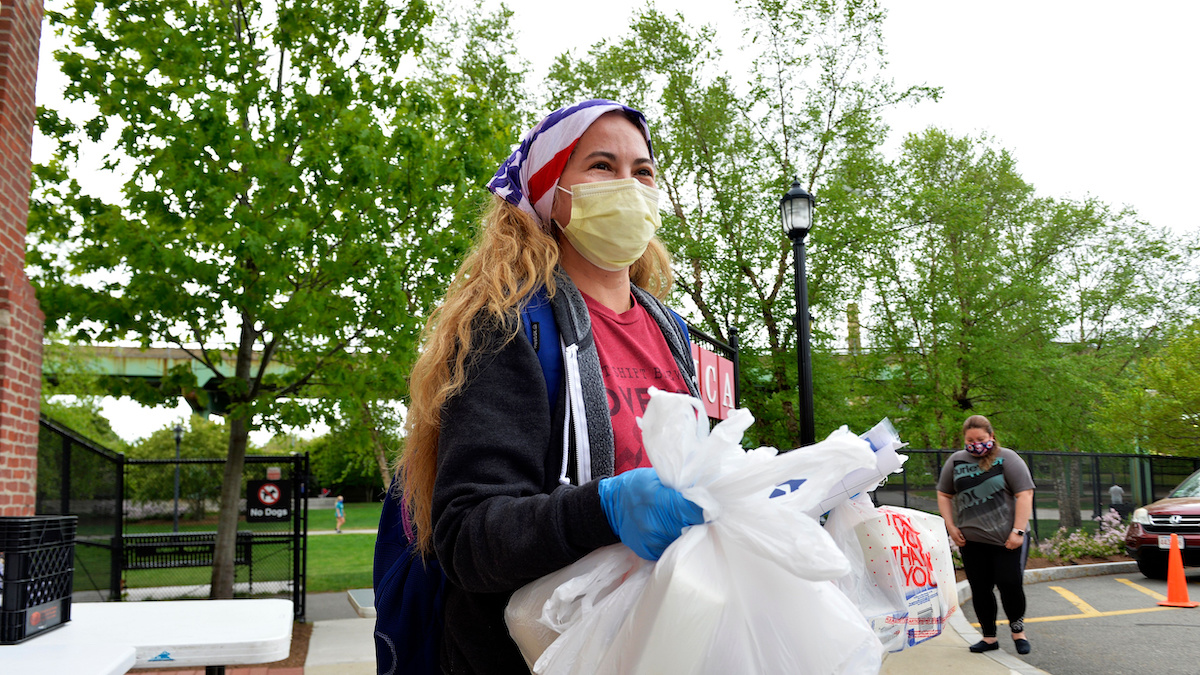

A women walks with COVID-19 care kits distributed by Boston's Office of Neighborhood Services in Boston, Massachusetts on May 28, 2020. The pandemic has led to a rise in single-use plastic items, but reusable bags and cloth masks can be two ways to reduce waste. JOSEPH PREZIOSO / AFP via Getty Images
Every year, Plastic Free July is a time when millions of people pledge to give up single-use plastics.
Last year, the month boasted around 250 million participants in 177 countries, but this year there’s a complication. The coronavirus pandemic is still very much with us, and it has led to a rise in single-use items, from personal protective equipment (PPE) to disposable coffee cups. In the U.S., many states have paused or backtracked on plastic bag bans, WIRED reported, and the UK has delayed its ban on plastic straws and stirrers by six months. Coffee shops including Starbucks have temporarily prohibited reusable mugs. And some U.S. grocery stores and states have gone so far as to prohibit personal shopping bags, as MPR News reported.
When it comes to plastic, the spread of the new disease has created a false dichotomy between public health and environmental stewardship. The organization City to Sea found that 36 percent of Brits feel pressured to use more plastic because of the pandemic. But it doesn’t have to be this way.
“Caring for the planet doesn’t mean we can’t care for ourselves,” Plastic Free July founder Rebecca Prince-Ruiz told The New York Times. “We can do both at the same time.”
Plastic Free July is a global movement that helps millions of people be part of the solution to plastic pollution – so we can have cleaner streets, oceans, and beautiful communities. Will you be part of #plasticfreejuly by choosing to refuse single-use plastics? pic.twitter.com/TelrNEr563
— Plastic Free July (@PlasticFreeJuly) June 30, 2020
Here are three ways you can go plastic-free this July while keeping yourself healthy and safe.
1. Use Bar Soap
COVID-19 has made everyone newly aware of the importance of washing their hands for at least 20 seconds with soap and water.
Surfers Against Sewage suggests doing this with bar soap instead of plastic soap dispensers to reduce waste. But is it really safe for everyone in your household to be handling the same bar?
That’s what Earther’s Yessenia Funes wondered until Stanford University soap expert Marlene Wolfe set her mind at rest.
“While bar soap is icky to a lot of people because it can become wet and cracked and look dirty, if you are touching it and then using it to wash your hands, whatever negligible amount might transfer to your hands should also be washed off during washing,” Wolfe said. “And there’s some work to suggest that bacteria are unlikely to transfer off of bar soap, and I would suspect this would hold for viruses.”
But if you really love those pump bottles, Wolfe recommends getting reusable ones and refilling them in bulk.
2. Wear a Cloth Mask
Wearing masks is vitally important for slowing the transmission of COVID-19, but, sadly, disposable masks and gloves are already ending up in the ocean.
You can protect yourself and the planet by choosing a cloth mask, experts told The New York Times. While N-95 respirators and surgical masks offer the best protection against the virus, experts say that, for the general public, cloth masks are plenty safe and much more sustainable. Both N-95 and surgical masks are made with petroleum products that do not break down, plus it is important to reserve them for frontline workers whose risk of exposure is greater. Disposable paper masks, another option, are slightly misnamed because they often contain lots of microplastics.
When it comes to selecting a cloth mask, it is better to use old clothing you already have at home, like a T-shirt or bandanna, than to buy a new one.
“Virgin fiber of any kind is going to require more energy, more resources and more toxic chemicals than something that has already been made,” University of California, Berkeley physician and environmental health researcher Dr. Megan Schwarzman told The New York Times.
3. Don’t Ditch Your Reusables
If you were using reusable shopping bags and food containers before the pandemic, you don’t have to abandon them now. And, if you haven’t yet picked up this habit, it is safe to start this Plastic Free July.
More than 100 scientists from 18 countries signed a statement last month saying that it was safe to use reusable items like bags, cups and utensils as long as they were properly cleaned.
“Single-use plastic is not inherently safer than reusables, and causes additional public health concerns once it is discarded,” the experts wrote.
The choice may be out of your control if your coffee shop, grocery store or state has banned reusable cups or bags, but you can participate in online campaigns to promote reusables.
In the the UK, City to Sea has started #ContactlessCoffee to encourage the safe use of refillable containers as cafes reopen. They are asking people to share the campaign video on social media while tagging their favorite local coffee joint and using the #ContactlessCoffee hashtag.
- COVID-19 Masks Are Polluting Beaches and Oceans - EcoWatch
- Plastic Packaging Use Increases During the Coronavirus - EcoWatch
- Coronavirus Worsens Thailand's Plastic Waste Crisis - EcoWatch
- Coronavirus Plastic Waste Polluting the Environment - EcoWatch
- Starbucks to Require All U.S. Customers to Mask Up - EcoWatch

 233k
233k  41k
41k  Subscribe
Subscribe 